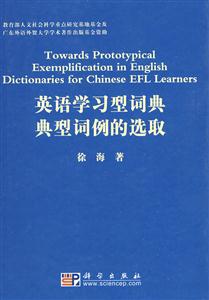英语学习型词典典型词例的选取(英文版)

|
英语学习型词典典型词例的选取(英文版)作者:徐海 开 本:16开 书号ISBN:9787030217899 定价:38.0 出版时间:2009-01-01 出版社:科学出版社 |
英语学习型词典典型词例的选取(英文版) 内容简介
本书主要探讨以下问题:①哪些因素影响英语学习型词典词例的选取?②这些因素如何影响典型词例的选取和呈现?③词典编纂者应当采取哪些策略确保选例的典型性?
在词例作为语篇的研究框架中,可确定至少有五个因素影响选例,即用例的意图、词例的语言信息量、词例的源语篇、词例所适配的词典语篇以及特定词典用户对词例的需求。因此,典型词例的选取须满足意图性、信息性、衔接性和可接受性等要求。
典型词例总是蕴含编纂意图。选例能否传达明确的意图,很大程度上取决于词典编纂者是否正确预测用户在何种情况下可能查询目标词,是否意识到解码意图的词例与编码目的的词例起着不同的作用。
就词例的信息性而言,词典编纂者须考虑语料库检索工具在词例选取中的运用以及相关的语言学理论对词例选取的启示。一些实用的检索工具,如wordsmith,world sketch engine和framenet等,可直接用于提取信息量大的词例。而信息丰富的词例通常显示目标词的语义、搭配和(或)句法信息。框架语义学阐明了词汇单位的典型框架以及框架成分,对于如何选取语义信息凸现的典型词例起着指导作用。相关的短语搭配研究则有助于选取搭配信息充分的词例。配价理论和句法转换理论中的一些规则对于词例的选择起着句法制约作用。
词例与源语篇之间的衔接问题主要是指示语的处理问题。据调查,人称指示语通常在词例中保留。具有口语语篇标记的方位指示语here和there很少出现在词例中。词例的时态(即时间指示语)通常限于一般现在时和一般过去时;其他类型的时态除非受动词语义的影响很少出现在词例中。
有关词例与词典语篇的衔接,编纂者须考虑词典语篇中的其他因素,包括词频、词性、词义以及词的标记性,对词例选取的影响。英语学习型词典一般例释无标记的高频词的用法。但为了满足一些用户的特殊查询需求,具有语体或感情色彩标记的词有时也配例。一个无标记的词通常每一义项配有两个以上的例子,而一个有标记的词通常每两个义项配有_例。至于词性的配例,动词、介词和形容词应首先考虑。
词例的接受性问题可用关联理论解释。一个*佳的例子是特定词典用户花*小的努力获得*大的语言信息。这就要求词典编纂者利用问卷调查的方法以及基于学习者语料库和平行语料库检索,考查特定用户的显性和隐性的词例查询需求。同时,词典编纂者应适当采用一些方式,如短语例与句例相结合、黑体、括注、警示例以及对词例中的不常用词、复杂结构、文化信息的控制等,有效呈现词例。
本书*后提出了一个英语学习型词典典型词例的选取与呈现的模式。
英语学习型词典典型词例的选取(英文版) 目录
序acknowledgements
abstract
摘要
abbreviations
chapter one introduction
1.1 rationale for the present research
1.2 overview of exemplification research
1.3 research objectives
1.4 research methodology
1.5 research framework
1.6 outline of the book
chapter two intentionality of illustrative examples
2.1 evidence for the functions of illustrative examples
2.1.1 psycholmguistic evidence
2.1.2 empirical evidence
2.2 nature of illustrative examples
2.2.1 infinite utterances vs. prototypical examples
2.2.2 syntagmatic relationship vs. paradigmatic relationship
2.3 classification of examples' functions
2.3.1 descriptive approach
2.3.2 user-oriented approach
2.3.3 a refined classification of examples' functions
2.3.4 a case study of the exemplification of the word monopoly
2.3.5 discussion
2.4 evincing lexicographic intentions in illustrative examples
2.5 summary
chapter three informativity of illustrative examples
3.1 impacts of technological innovations on the choice of dictionary examples
3.1.1 manual collection of data
3.1.2 computer corpus and kwic concordancing
3.1.3 word sketch engine
3.1.4 framenet concordancing
3.1.5 summary of the technological advances
3.2 semantic information in illustrative examples
3.2.1 overview of frame semantics
3.2.2 implications of frame semantics for lexicography
3.2.3 application of frame semantics to exemplification: a case study of the lemma conclude
3.2.4 procedures for selecting informative examples from corpus
3.3 combinatory information in illustrative examples
3.3.1 significance of word combinatory information in linguistics and in lexicography
3.3.2 classification of word combinations: an overview
3.3.3 approaches to phraseological study
3.3.4 method
3.3.5 results
3.3.6 discussion
3.3.7 principles of exemplifying collocations
3.4 syntactic information in illustrative examples
外语 英语专项训练 词汇
在线阅读
- 最新内容
- 相关内容
- 网友推荐
- 图文推荐
| [高考] 2022 西安电子科技大学《软件工程》大作业答案 (2022-04-25) |
| [家长教育] 孩子为什么会和父母感情疏离? (2019-07-14) |
| [教师分享] 给远方姐姐的一封信 (2018-11-07) |
| [教师分享] 伸缩门 (2018-11-07) |
| [教师分享] 回家乡 (2018-11-07) |
| [教师分享] 是风味也是人间 (2018-11-07) |
| [教师分享] 一句格言的启示 (2018-11-07) |
| [教师分享] 无规矩不成方圆 (2018-11-07) |
| [教师分享] 第十届全国教育名家论坛有感(二) (2018-11-07) |
| [教师分享] 贪玩的小狗 (2018-11-07) |






